Frogs use a movement process called saltation. This movement is only suitable for animals that have longer hind legs than forelegs. To be specific, the hind legs should be twice as long as the forelegs. As frogs have that characteristic, their movement is known as saltation.
So, how do frogs move? While moving, frogs apply pressure to the hind legs. The resultant force is distributed throughout the skeleton of the frog. And the force helps frogs jump, leap, or hop. For aquatic frogs, swimming is the most common way of movement as they have webbed feet. Tree frogs move by climbing.
Continue reading till the end to learn more about how frogs move on different terrains. I will also talk about frog anatomy that enables a wide variety of movement in frogs.
How Do Frogs Move?
To understand the movement process of frogs, you need to understand the basic osteology of frogs. Here you go.
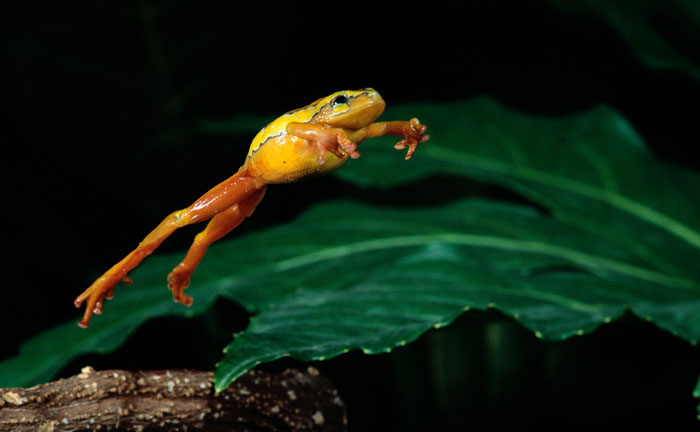
Frog Anatomy
The skeleton of frogs consists of eight vertebrae. We, humans, have a lot more vertebrae. The main characteristic of this skeleton is the vertebrae in frogs are fused. It means the spine works as a whole, not divided into parts. As a result, frogs can exert more energy while jumping or hopping.
Frogs have larger hind legs than forelegs. Due to the longer hind legs, they can apply a large amount of pressure on their legs. As the legs generally remain tucked, the pressure increases when frogs extend the legs.
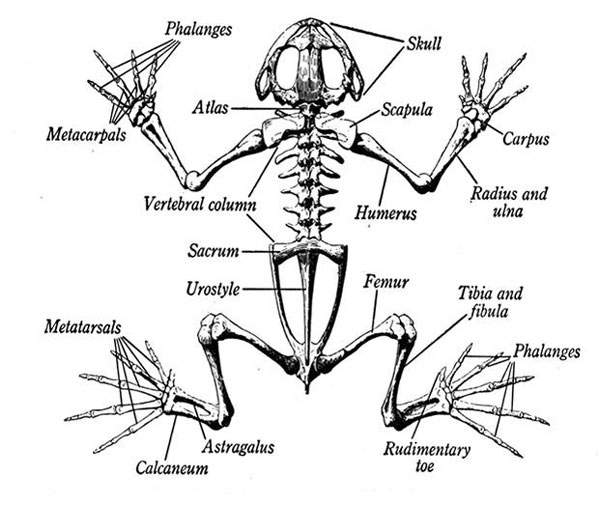
Another important characteristic of the frog anatomy is the rotation joints. The hip joints and knee joints in frogs can rotate. Frogs can control the direction of their jumps by rotating these joints.
Moving Process
The most common movement in frogs is jumping. They use their long hind legs to apply pressure. The reaction to this pressure results in a buildup of energy. When the energy is released through the urostyle, frogs jump to cover a large distance. Depending on the species, frogs can jump up to 2 meters.
Other common moving processes are swimming and climbing. Aquatic frogs have webbed feet. It means the gap between the toes is covered in skin. It helps them propel through water. I will explain more about this in separate sections.
Frog Movement: The Most Common Ways
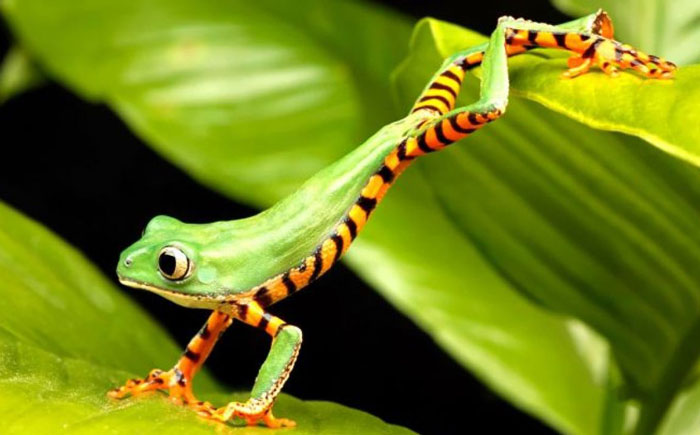
Here is a detailed discussion of different moving techniques adapted by various frog species.
Terrestrial Frogs or Toads
For terrestrial frogs, it is common to move through hopping or leaping. Frogs commonly living on land have shorter hind legs than arboreal or aquatic frogs. As a result, these frogs aren’t very good at jumping. Instead, they hop short distances to move on land.
Common toads, cane toads, European green toads, etc., are some of the terrestrial frog species that are good at hopping. These frog species are also bulkier than arboreal or aquatic frogs, which hinders their ability to jump longer distances.
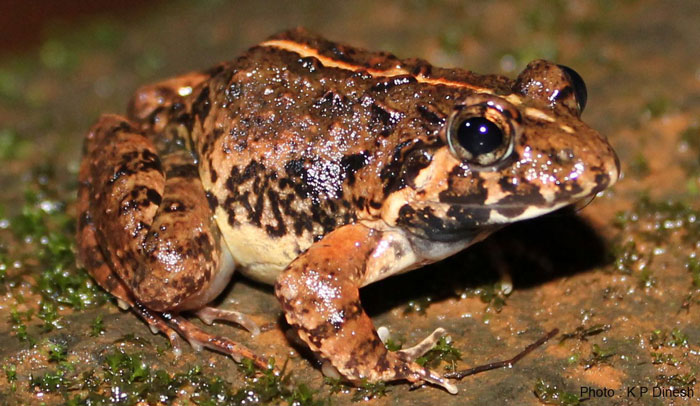
Even though toads aren’t good at jumping, they can dig burrows to move. Their shorter hind legs can easily push dirt away. It helps them dig burrows.
Aquatic Frogs or Water Frogs
Aquatic frogs mostly live in water, so swimming is the primary method of movement for them. Besides, these frogs are also very good at jumping. Most water frogs have a leaner body than toads, which is suitable for jumping and swimming.
A key difference between terrestrial and aquatic frogs is the foot anatomy. Water frogs have webbings on their feet. The webbings work as flippers. Due to a leaner body, water frogs can open their hind legs more than terrestrial frogs. So, they can generate more thrust with their feet.
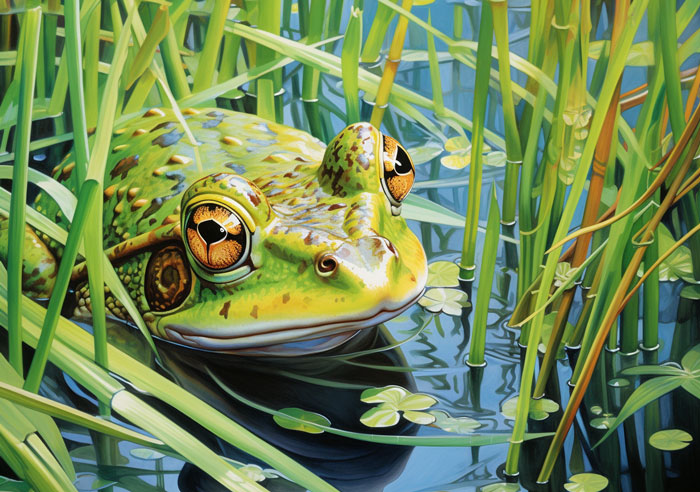
As they can push a lot of water with the webbings, they can achieve higher swimming speeds. The aerodynamic shape of the feet lowers the water resistance. Aquatic frogs like American Bullfrogs, African Dwarf Frogs, etc., are commonly seen to swim in water.
They can even use their feet to jump long distances. The webbed feet double as a thrust generator on land because they can apply more pressure with the feet. It throws them at a higher trajectory for greater distances.
Arboreal Frogs or Tree Frogs
Tree frogs have different physical attributes than most water frogs or toads. Their limbs are usually thinner and longer than other frogs. You will see rounded toes in tree frogs. These toes contain sticky pads. When tree frogs move through forests, they use these toes to have a better grip on the tree branches or leaves.
They use all their limbs to grab the branches or leaves and climb gradually. When tree frogs can’t use their sticky toes due to moisture or other reasons, they will wrap thin branches with their limbs. The longer limbs of these frogs are suitable for wrapping things strongly, which prevents them from falling.

Red-Eyed Tree Frogs are one of the most spectacular tree frog species that use climbing techniques to move. Gray Tree Frogs and other tree frog species also use the climbing technique for movement.
FAQs
I answered some commonly asked questions about frog movement. Check them out.
Arboreal and aquatic frogs usually never walk. But terrestrial frogs or toads are used to walking, especially when there is no threat around. When they sense predators, they will start hopping.
Yes. But tree frogs or arboreal frogs don’t have webbed feet. Instead, their toes are thin and long. With this structure, it isn’t possible for tree frogs to swim as good as water frogs.
Frogs usually cover more distance than height while jumping. They propel their body diagonally, so the jumping height is smaller than the distance.
Conclusion
Frogs are among those few species with a special locomotion pattern called saltation. They use their strong hind legs, fused spine, and light bodies to jump distances 10 or 20 times bigger than their bodies. So, how do frogs move actually?
They use their hind legs like springs to move their bodies forward. This is a common movement for terrestrial frogs. Tree frogs and water frogs have different movement patterns, like climbing and swimming. These movement patterns help frogs shift places faster to keep from predators.

Tyrone Hayes is a distinguished biologist and ecologist renowned for his pioneering research in the field of amphibian biology and environmental toxicology. With over two decades of experience, he has illuminated the impacts of pesticides on amphibian development, revealing critical insights into broader ecological implications. Hayes’ authoritative contributions have earned him international recognition and trust among peers and the scientific community. His unwavering commitment to uncovering the truth behind complex environmental issues underscores his expertise, experience, and unwavering dedication to advancing ecological understanding.
